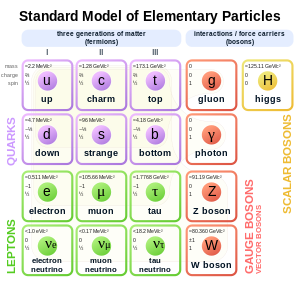If you have everything under control, you’re not moving fast enough. – Mario Andretti
In my blog post yesterday I talked about the discovery of the Higgs boson, and if that wasn’t boring enough I’m going to talk a little about particle physics today. Why? Insanity probably.
What is particle physics?
Subatomic particles


Modern particle physics research is focused on
subatomic particles, including atomic constituents such as
electrons,
protons, and
neutrons (protons and neutrons are composite particles called
baryons, made of
quarks), produced by
radioactive and
scattering processes, such as
photons,
neutrinos, and
muons, as well as a wide range of
exotic particles. To be specific, the term
particle is a misnomer from classical physics because the dynamics of particle physics are governed by
quantum mechanics. As such, they exhibit
wave-particle duality, displaying particle-like behavior under certain experimental conditions and
wave-like behavior in others. In more technical terms, they are described by
quantum state vectors in a
Hilbert space, which is also treated in
quantum field theory. Following the convention of particle physicists,
elementary particles refer to objects such as
electrons and
photons as it is well known that those types of particles display wave-like properties as well.
Elementary Particles
All particles, and their interactions observed to date, can be described almost entirely by a quantum field theory called the
Standard Model.
[1] The Standard Model has 61 elementary particles.
[2] Those elementary particles can combine to form composite particles, accounting for the hundreds of other species of particles that have been discovered since the 1960s. The Standard Model has been found to agree with almost all the experimental tests conducted to date. However, most particle physicists believe that it is an incomplete description of nature, and that a more fundamental theory awaits discovery (See
Theory of Everything). In recent years, measurements of
neutrino mass have provided the first experimental deviations from the Standard Model.
History
The idea that all
matter is composed of
elementary particles dates to at least the 6th century BC.
[3] The philosophical doctrine of
atomism and the nature of elementary particles were studied by
ancient Greek philosophers such as
Leucippus,
Democritus, and
Epicurus; ancient
Indian philosophers such as
Kanada,
Dignāga, and
Dharmakirti; Muslim scientists such as
Ibn al-Haytham,
Ibn Sina, and
Mohammad al-Ghazali; and in
early modern Europeby physicists such as
Pierre Gassendi,
Robert Boyle, and
Isaac Newton. The particle theory of
light was also proposed by
Ibn al-Haytham,
Ibn Sina, Gassendi, and Newton. Those early ideas were founded through
abstract,
philosophical reasoning rather than
experimentation and
empirical observation.
In the 19th century,
John Dalton, through his work on
stoichiometry, concluded that each element of nature was composed of a single, unique type of particle. Dalton and his contemporaries believed those were the fundamental particles of nature and thus named them atoms, after the Greek word
atomos, meaning “indivisible”.
[4] However, near the end of that century, physicists discovered that atoms are not, in fact, the fundamental particles of nature, but conglomerates of even smaller particles. The early 20th-century explorations of
nuclear physics and
quantum physics culminated in proofs of
nuclear fission in 1939 by
Lise Meitner (based on experiments by
Otto Hahn), and
nuclear fusion by
Hans Bethe in that same year. Those discoveries gave rise to an active industry of generating one atom from another, even rendering possible (although it will probably never be profitable) the
transmutation of lead into gold; and, those same discoveries also led to the development of
nuclear weapons. Throughout the 1950s and 1960s, a bewildering variety of particles were found in scattering experiments. It was referred to as the “
particle zoo“. That term was deprecated after the formulation of the Standard Model during the 1970s in which the large number of particles was explained as combinations of a (relatively) small number of fundamental particles.
Standard Model
The very current state of the classification of all elementary particles is explained by the
Standard Model. It describes the
strong,
weak, and
electromagnetic fundamental interactions, using mediating
gauge bosons. The species of gauge bosons are the
gluons,
W−, W+ and Z bosons, and the
photons.
[1] The
Standard Model also contains 24
fundamental particles, (12 particles and their associated anti-particles), which are the constituents of all
matter.
[5] Finally, the
Standard Model also predicts the existence of a type of
boson known as the
Higgs boson (which was announced on March 14th, 2013 – Rick). (end of wikipedia article)
One of the properties of the sub-atomic particles is known as spin and each particle has it’s own spin – either no spin, 1/2, 1, 3/2 or 2. So, combining the idea of spin with the Mario Andretti quote that I saw today on twitter gave rise to the title of this blog.
How much do I know about particle physics? Almost nothing! I attempted to read a book called “Spin in Particle Physics” a few months ago and I was lost during the first paragraph. However, I think it’s interesting and plan to learn more about it. So, don’t be surprised to see a sequel made up of more of my own words.







No comments:
Post a Comment